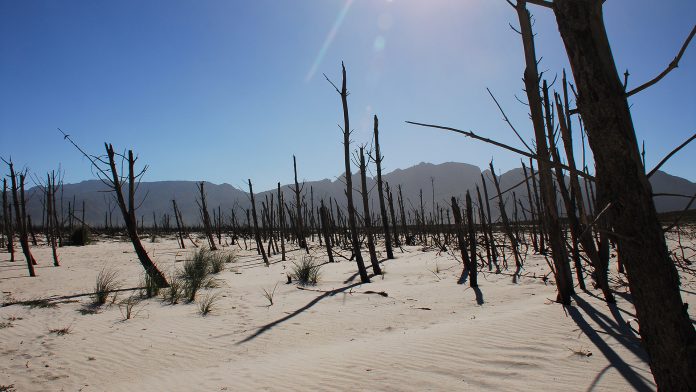New research indicates that climate change could result in a staggering doubling of the frequency of extreme regional summer droughts in Europe.
The ongoing climate crisis is already reaping havoc worldwide. For example, droughts are now significant high-impact hydro-meteorological hazards across the world. Specifically in Europe, the impacts of the climate crisis have been severe, with droughts resulting in considerable social, economic, and environmental losses already, particularly in the years 2003, 2010, and 2018.
Climate projections indicate that more recurring and dangerous weather events are projected to occur by the end of this century. Investigating the future incidence of droughts is critical for sufficient climate crisis mitigation.
A novel study, published in Frontiers in Water, highlights that Europe is moving in the direction of a future of further severe and extreme droughts.
“Summer droughts are a highly relevant topic in Europe,” said author Magdalena Mittermeier, who is the co-first author with Andrea Böhnisch, both from the Ludwig-Maximilians-Universität München (LMU) in Germany. “We find a clear trend towards more, longer and more intense summer droughts, in terms of a precipitation deficit, towards the end of the century under a high-emission carbon scenario (RCP8.5).”
According to the World Health Organization (WHO), droughts are the most dangerous threat to crops and livestock in every part of the world, with approximately 55 million people impacted by them every year across the globe.
The consequences of droughts are economically, socially, and environmentally complicated, and a universal definition that covers all the impacts does not exist. Instead, droughts are categorised by their effects as meteorological, hydrological, agricultural, or socio-economic. Meteorological droughts are a potential predecessor of other drought types and are thus integral to the research efforts.
Research outcomes
- In the long-term, Europe will experience a frequency and intensity increase of summer droughts and a lesser quantity of winter droughts in various regions in various climates.
- Both in the present day and in the future, there is a high inconsistency in drought intensities across numerous European climate regions.
- For mid-Europe, the yearly occurrence likelihood of an extreme drought sharply rises throughout the summer months, amounting to 25%. In Eastern Europe and the Alps, severe and extreme droughts have greater probabilities in the far future, with values around 20% (severe) and 40% (extreme).
- For France, the models forecast a rise in the occurrence of extreme droughts of up to 60%.
- In the Mediterranean, the percentages of extreme droughts in the far future could reach around 80% for the summer months.
- In the Iberian Peninsula, the percentage of extreme droughts is the highest of all regions, reaching 96% in July and 88% in August. In these two regions, however, the absolute precipitation values in July and August are already low in the reference period (each contributing only around 2 to 3% to the annual precipitation). This means that comparatively small absolute changes can lead to high percentages of the PNI, which is a relative measure.
- France, the Alps, the Mediterranean, and the Iberian Peninsula were identified as the drought hot spots of the future. These areas could see an expansion of more than 50% in the frequency of extreme summer droughts.
Examining drought occurrence
Regional variations amongst drought events are significant, and there is a desperate necessity to distinguish geographical hot spots for potential drought events. Böhnisch and her team at the Ludwig-Maximilians University and the Ouranos Consortium in Canada evaluated existing and upcoming climate trends and drought hot spots for Europe.
The researchers split up Europe into eight regions with distinct climates: the British Isles, Scandinavia, mid-Europe, the Alps, Eastern Europe, France, the Mediterranean and the Iberian Peninsula. The group then investigated the ´percent of normal index´ (PNI, which provides the percentage of precipitation in a given period in comparison to the normal precipitation in the reference period) in a single climate model over the eight regions. A long-term future (from 2080 to 2099) under the Representative Concentration Pathway 8.5 was compared to the present day (2001 to 2020).
European drought hot spots
The findings of the study indicate an overall growth in drought numbers, with a high inconsistency of drought intensities among regions in the present-day period and the anticipated far future. In the long-term future, summer droughts are forecast to become more extreme, whereas winter droughts will likely become less common in several regions.
“Our study shows that unabated climate change will worsen the risk of hot-spot droughts drastically. But also, in some regions where droughts currently play a minor role, the future drought risk is expected to get serious. We show that the Alps should be considered an additional future hot-spot,” added Mittermeier.
“Unmitigated climate change, under the RCP8.5 scenario, will drastically increase the frequency, duration and intensity of summer droughts in many European regions. Such extreme effects can be avoided by climate mitigation. This is why consistent mitigation of climate change as agreed on under the Paris Agreement is highly relevant in terms of droughts in Europe.
“These three key features of: first, increasing drought occurrence in summer; second, wetter conditions in winter as well as; and third, interannual variations due to the natural variability of the climate system are visualised in what we call ‘drying stripes’.
“These allow an overview of our results at first glance. The drying stripes show the percentage of precipitation for every month and year summarised over our ensemble compared to the long-term mean in a counterfactual world with pre-industrial greenhouse gas concentrations. With this, they show the projected summer drying trend throughout the 21st century compared to a world without climate change.”









